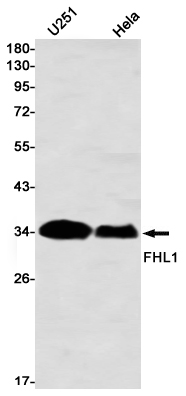

| WB | 1/500-1/1000 | Human,Mouse,Rat |
| IF | 1/20 | Human,Mouse,Rat |
| IHC | 1/50-1/100 | Human,Mouse,Rat |
| ICC | 技术咨询 | Human,Mouse,Rat |
| FCM | 咨询技术 | Human,Mouse,Rat |
| Elisa | 咨询技术 | Human,Mouse,Rat |
| Aliases | FHL1; FHL1A; FHL1B; FLH1A; RBMX1A; RBMX1B; SLIM1; SLIMMER; XMPMA |
| Entrez GeneID | 2273 |
| WB Predicted band size | Calculated MW: 36 kDa; Observed MW: 36 kDa |
| Host/Isotype | Rabbit IgG |
| Antibody Type | Primary antibody |
| Storage | Store at 4°C short term. Aliquot and store at -20°C long term. Avoid freeze/thaw cycles. |
| Species Reactivity | Human |
| Immunogen | Recombinant protein of human FHL1 |
| Formulation | Purified antibody in TBS with 0.05% sodium azide,0.05%BSA and 50% glycerol. |
+ +
以下是3篇关于FHL1抗体的研究文献示例(文献名称、作者及摘要概括):
---
1. **文献名称**:*FHL1 mutations causing reducing body myopathy: Functional analysis of clinical phenotypes*
**作者**:Schessl et al.
**摘要**:研究通过免疫组化与FHL1抗体检测,揭示了FHL1基因突变导致进行性肌营养不良的机制,发现突变蛋白在肌肉组织中异常聚集,破坏细胞骨架稳定性。
---
2. **文献名称**:*FHL1 interacts with dysferlin and regulates sarcolemmal repair*
**作者**:Kawai et al.
**摘要**:利用FHL1抗体进行共沉淀实验,证实FHL1与dysferlin蛋白相互作用,参与肌细胞膜修复过程,其缺失与肢带型肌营养不良症(LGMD)的病理相关。
---
3. **文献名称**:*Antibody-based profiling reveals expression of FHL1 in hypertrophic cardiomyopathy*
**作者**:Friedrich et al.
**摘要**:通过Western blot和免疫荧光技术,发现FHL1在肥厚型心肌病患者心肌组织中高表达,提示其可能作为心肌肥厚和纤维化的潜在生物标志物。
---
(注:以上文献为示例,实际引用需核对具体论文信息。)
**Background of FHL1 Antibody**
FHL1 (Four and a Half LIM Domains 1) is a member of the LIM protein family, characterized by zinc-binding domains critical for protein-protein interactions and cellular signaling. Expressed predominantly in skeletal and cardiac muscle, FHL1 plays roles in mechanotransduction, cytoskeletal organization, and transcriptional regulation. Mutations in the *FHL1* gene are linked to rare musculoskeletal disorders, including Emery-Dreifuss muscular dystrophy (EDMD), reducing body myopathy (RBM), and X-linked myopathy with postural muscle atrophy (XMPMA).
FHL1 antibodies are essential tools for studying its expression, localization, and function. In research, they are used in techniques like Western blotting, immunohistochemistry, and immunofluorescence to detect FHL1 isoforms (FHL1A, FHL1B, FHL1C) in tissues or cell lines. Clinically, these antibodies aid in diagnosing FHL1-related myopathies by identifying abnormal protein aggregates or reduced expression in muscle biopsies.
Additionally, autoantibodies against FHL1 have been reported in certain autoimmune conditions, though their pathogenic role remains unclear. Research continues to explore FHL1's involvement in muscle repair, hypertrophy, and disease mechanisms, highlighting its dual role as a structural scaffold and signaling mediator. The development of specific FHL1 antibodies thus supports both basic research and diagnostic applications in neuromuscular disorders.
×